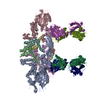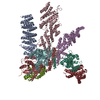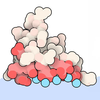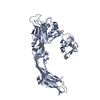+ Open data
Open data
- Basic information
Basic information
| Entry | Database: EMDB / ID: EMD-8187 | |||||||||
|---|---|---|---|---|---|---|---|---|---|---|
| Title | aerolysin pore cryo-EM map | |||||||||
 Map data Map data | aerolysin WT pore in LMNG mmicelle | |||||||||
 Sample Sample |
| |||||||||
 Keywords Keywords | pore forming toxin / concentric beta-barrel / aerolysin / Toxin | |||||||||
| Function / homology |  Function and homology information Function and homology informationtoxin activity / host cell plasma membrane / extracellular region / identical protein binding / membrane Similarity search - Function | |||||||||
| Biological species |  Aeromonas hydrophila (bacteria) Aeromonas hydrophila (bacteria) | |||||||||
| Method | single particle reconstruction / cryo EM / Resolution: 7.4 Å | |||||||||
 Authors Authors | Iacovache I / Zuber B | |||||||||
| Funding support |  Switzerland, 1 items Switzerland, 1 items
| |||||||||
 Citation Citation |  Journal: Nat Commun / Year: 2016 Journal: Nat Commun / Year: 2016Title: Cryo-EM structure of aerolysin variants reveals a novel protein fold and the pore-formation process. Authors: Ioan Iacovache / Sacha De Carlo / Nuria Cirauqui / Matteo Dal Peraro / F Gisou van der Goot / Benoît Zuber /    Abstract: Owing to their pathogenical role and unique ability to exist both as soluble proteins and transmembrane complexes, pore-forming toxins (PFTs) have been a focus of microbiologists and structural ...Owing to their pathogenical role and unique ability to exist both as soluble proteins and transmembrane complexes, pore-forming toxins (PFTs) have been a focus of microbiologists and structural biologists for decades. PFTs are generally secreted as water-soluble monomers and subsequently bind the membrane of target cells. Then, they assemble into circular oligomers, which undergo conformational changes that allow membrane insertion leading to pore formation and potentially cell death. Aerolysin, produced by the human pathogen Aeromonas hydrophila, is the founding member of a major PFT family found throughout all kingdoms of life. We report cryo-electron microscopy structures of three conformational intermediates and of the final aerolysin pore, jointly providing insight into the conformational changes that allow pore formation. Moreover, the structures reveal a protein fold consisting of two concentric β-barrels, tightly kept together by hydrophobic interactions. This fold suggests a basis for the prion-like ultrastability of aerolysin pore and its stoichiometry. | |||||||||
| History |
|
- Structure visualization
Structure visualization
| Movie |
 Movie viewer Movie viewer |
|---|---|
| Structure viewer | EM map:  SurfView SurfView Molmil Molmil Jmol/JSmol Jmol/JSmol |
| Supplemental images |
- Downloads & links
Downloads & links
-EMDB archive
| Map data |  emd_8187.map.gz emd_8187.map.gz | 1.8 MB |  EMDB map data format EMDB map data format | |
|---|---|---|---|---|
| Header (meta data) |  emd-8187-v30.xml emd-8187-v30.xml emd-8187.xml emd-8187.xml | 11.6 KB 11.6 KB | Display Display |  EMDB header EMDB header |
| FSC (resolution estimation) |  emd_8187_fsc.xml emd_8187_fsc.xml | 5.1 KB | Display |  FSC data file FSC data file |
| Images |  emd_8187.png emd_8187.png | 42.4 KB | ||
| Filedesc metadata |  emd-8187.cif.gz emd-8187.cif.gz | 5.7 KB | ||
| Archive directory |  http://ftp.pdbj.org/pub/emdb/structures/EMD-8187 http://ftp.pdbj.org/pub/emdb/structures/EMD-8187 ftp://ftp.pdbj.org/pub/emdb/structures/EMD-8187 ftp://ftp.pdbj.org/pub/emdb/structures/EMD-8187 | HTTPS FTP |
-Validation report
| Summary document |  emd_8187_validation.pdf.gz emd_8187_validation.pdf.gz | 239.1 KB | Display |  EMDB validaton report EMDB validaton report |
|---|---|---|---|---|
| Full document |  emd_8187_full_validation.pdf.gz emd_8187_full_validation.pdf.gz | 238.2 KB | Display | |
| Data in XML |  emd_8187_validation.xml.gz emd_8187_validation.xml.gz | 8.3 KB | Display | |
| Arichive directory |  https://ftp.pdbj.org/pub/emdb/validation_reports/EMD-8187 https://ftp.pdbj.org/pub/emdb/validation_reports/EMD-8187 ftp://ftp.pdbj.org/pub/emdb/validation_reports/EMD-8187 ftp://ftp.pdbj.org/pub/emdb/validation_reports/EMD-8187 | HTTPS FTP |
-Related structure data
| Related structure data |  5jztMC  8185C  8188C  5jzhC  5jzwC M: atomic model generated by this map C: citing same article ( |
|---|---|
| Similar structure data |
- Links
Links
| EMDB pages |  EMDB (EBI/PDBe) / EMDB (EBI/PDBe) /  EMDataResource EMDataResource |
|---|---|
| Related items in Molecule of the Month |
- Map
Map
| File |  Download / File: emd_8187.map.gz / Format: CCP4 / Size: 12.9 MB / Type: IMAGE STORED AS FLOATING POINT NUMBER (4 BYTES) Download / File: emd_8187.map.gz / Format: CCP4 / Size: 12.9 MB / Type: IMAGE STORED AS FLOATING POINT NUMBER (4 BYTES) | ||||||||||||||||||||||||||||||||||||||||||||||||||||||||||||||||||||
|---|---|---|---|---|---|---|---|---|---|---|---|---|---|---|---|---|---|---|---|---|---|---|---|---|---|---|---|---|---|---|---|---|---|---|---|---|---|---|---|---|---|---|---|---|---|---|---|---|---|---|---|---|---|---|---|---|---|---|---|---|---|---|---|---|---|---|---|---|---|
| Annotation | aerolysin WT pore in LMNG mmicelle | ||||||||||||||||||||||||||||||||||||||||||||||||||||||||||||||||||||
| Projections & slices | Image control
Images are generated by Spider. | ||||||||||||||||||||||||||||||||||||||||||||||||||||||||||||||||||||
| Voxel size | X=Y=Z: 1.68 Å | ||||||||||||||||||||||||||||||||||||||||||||||||||||||||||||||||||||
| Density |
| ||||||||||||||||||||||||||||||||||||||||||||||||||||||||||||||||||||
| Symmetry | Space group: 1 | ||||||||||||||||||||||||||||||||||||||||||||||||||||||||||||||||||||
| Details | EMDB XML:
CCP4 map header:
| ||||||||||||||||||||||||||||||||||||||||||||||||||||||||||||||||||||
-Supplemental data
- Sample components
Sample components
-Entire : aerolysin pore
| Entire | Name: aerolysin pore |
|---|---|
| Components |
|
-Supramolecule #1: aerolysin pore
| Supramolecule | Name: aerolysin pore / type: complex / ID: 1 / Parent: 0 / Macromolecule list: all Details: Aerolysin oligomer in it's pore conformation in LMNG micelles. |
|---|---|
| Source (natural) | Organism:  Aeromonas hydrophila (bacteria) Aeromonas hydrophila (bacteria) |
| Molecular weight | Theoretical: 350 KDa |
-Macromolecule #1: Aerolysin
| Macromolecule | Name: Aerolysin / type: protein_or_peptide / ID: 1 / Number of copies: 7 / Enantiomer: LEVO |
|---|---|
| Source (natural) | Organism:  Aeromonas hydrophila (bacteria) Aeromonas hydrophila (bacteria) |
| Molecular weight | Theoretical: 47.185152 KDa |
| Recombinant expression | Organism:  |
| Sequence | String: AEPVYPDQLR LFSLGQGVCG DKYRPVNREE AQSVKSNIVG MMGQWQISGL ANGWVIMGPG YNGEIKPGTA SNTWCYPTNP VTGEIPTLS ALDIPDGDEV DVQWRLVHDS ANFIKPTSYL AHYLGYAWVG GNHSQYVGED MDVTRDGDGW VIRGNNDGGC D GYRCGDKT ...String: AEPVYPDQLR LFSLGQGVCG DKYRPVNREE AQSVKSNIVG MMGQWQISGL ANGWVIMGPG YNGEIKPGTA SNTWCYPTNP VTGEIPTLS ALDIPDGDEV DVQWRLVHDS ANFIKPTSYL AHYLGYAWVG GNHSQYVGED MDVTRDGDGW VIRGNNDGGC D GYRCGDKT AIKVSNFAYN LDPDSFKHGD VTQSDRQLVK TVVGWAVNDS DTPQSGYDVT LRYDTATNWS KTNTYGLSEK VT TKNKFKW PLVGETELSI EIAANQSWAS QNGGSTTTSL SQSVRPTVPA RSKIPVKIEL YKADISYPYE FKADVSYDLT LSG FLRWGG NAWYTHPDNR PNWNHTFVIG PYKDKASSIR YQWDKRYIPG EVKWWDWNWT IQQNGLSTMQ NNLARVLRPV RAGI TGDFS AESQFAGNIE IGAPVPLAA UniProtKB: Aerolysin |
-Experimental details
-Structure determination
| Method | cryo EM |
|---|---|
 Processing Processing | single particle reconstruction |
| Aggregation state | particle |
- Sample preparation
Sample preparation
| Concentration | 0.4 mg/mL |
|---|---|
| Buffer | pH: 7.4 |
| Grid | Model: Quantifoil R2/1 / Material: COPPER / Mesh: 300 / Support film - Material: CARBON / Support film - topology: HOLEY / Pretreatment - Type: GLOW DISCHARGE / Pretreatment - Time: 30 sec. |
| Vitrification | Cryogen name: ETHANE / Chamber humidity: 70 % / Chamber temperature: 295 K / Instrument: FEI VITROBOT MARK IV Details: 30 seconds glow discharged grids, 4ul sample, 5 seconds blot. |
- Electron microscopy
Electron microscopy
| Microscope | FEI TECNAI F20 |
|---|---|
| Image recording | Film or detector model: FEI FALCON II (4k x 4k) / Detector mode: INTEGRATING / Average exposure time: 1.0 sec. / Average electron dose: 22.42 e/Å2 |
| Electron beam | Acceleration voltage: 200 kV / Electron source:  FIELD EMISSION GUN FIELD EMISSION GUN |
| Electron optics | Illumination mode: FLOOD BEAM / Imaging mode: BRIGHT FIELD |
| Experimental equipment |  Model: Tecnai F20 / Image courtesy: FEI Company |
 Movie
Movie Controller
Controller















 Z (Sec.)
Z (Sec.) Y (Row.)
Y (Row.) X (Col.)
X (Col.)























